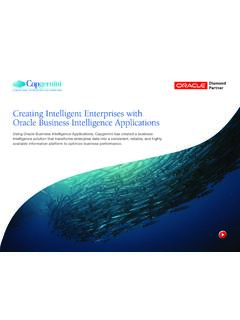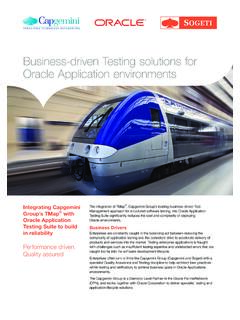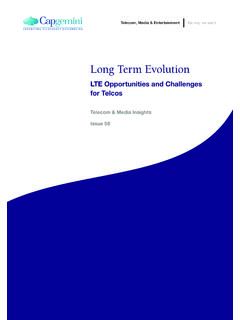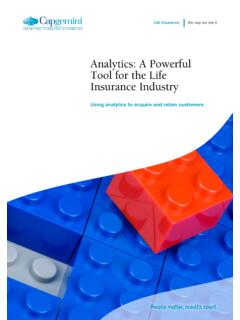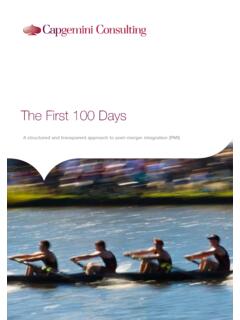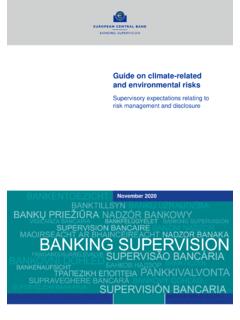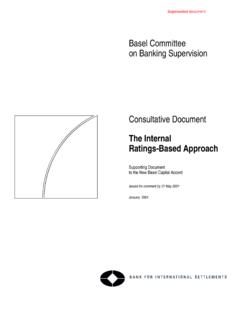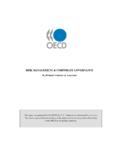Transcription of Basel III Comparison of Standardized and Advanced Approaches
1 Basel III: Comparison of Standardized and Advanced ApproachesImplementation and RWA Calculation Timelinesthe way we see itRisk & ComplianceThe information contained in this document is proprietary. 2014 Capgemini. All rights reserved. Rightshore is a trademark belonging to of Contents1. Executive Summary 32. Introduction 43. Applicability & Timeline Standardized approach Advanced Approaches Market Risk Rule 54. Risk-Weighted Asset Calculations General Formula Credit Risk Market Risk Operational Risk 135. Conclusion 14 Table of ContentsIn an effort to continue to strengthen the risk management frameworks of banking organizations and foster stability in the financial sector, the Basel Committee for Banking Supervision (BCBS) introduced, in December 2010, Basel III: A global regulatory framework for more resilient banks and banking systems. Subsequently, in July 2013, US regulators introduced their version of the BCBS framework, the Basel III US Final Rule1.
2 The Final Rule, which outlines the US Basel III framework, details two implementation Approaches : The Standardized approach The Advanced approachesTo help banking clients understand what this means to their businesses, Capgemini has compared and evaluated both Approaches , based on: Implementation timelines as mandated by regulation Risk-weighted asset (RWA) calculations for credit Market and operational risks Applicability to banks of all sizes large or small A Glass Half FullWhile the Standardized approach of Basel III introduces a more risk-sensitive treatment for various exposure categories than that of Basel II, the Advanced Approaches add another layer of complexity, by requiring that applicable banks employ more robust and accurate internal models for risk quantification. In order to perform an as-is and to-be analysis of the capital framework, it is important to understand the similarities and differences between these two Approaches .
3 This is particularly important for banks intending to progress from the Standardized approach to the Advanced Approaches , as a result of growth or ambition for a more accurate and sensitive representation of the risks they tends to see these new rules and regulations as a glass that is half full an opportunity for long-term growth, rather than a burden on existing resources. From Complexity to ComplianceBy providing end-to-end solutions from initial strategy and development to ground-level implementation, Capgemini is uniquely qualified to help clients cross the bridge from complexity to compliance. With a depth of domain expertise and industry-leading technological capabilities, Capgemini partners with clients to effectively guide them along a path of sustainable growth, while meeting regulatory Executive Summary1 Federal Register, Vol. 78, No. 198, Friday, October 11, 2013, Rules and Regulations, way we see itIn July 2013, the Board of Governors of the Federal Reserve System, the Office of the Comptroller of the Currency (OCC), and the Federal Deposit Insurance Corporation (FDIC), published in the Federal Register, the Final Rules, which outline the US Basel III capital framework.
4 Based on comments these rules consolidate three separate notices of proposed rulemaking (NPR) the Basel III NPR, the Standardized approach NPR, and the Advanced Approaches NPR in addition to selected Standardized and Advanced Approaches contain some noticeable and significant differences, including using prescribed risk weights under the Standardized approach , whereas the Advanced Approaches require the implementation of models based upon a bank s experience with its internal rating grades. Banking organizations with consolidated assets valued at greater than $250 billion or foreign exposure greater than $10 billion, are mandated to use the Advanced Approaches in addition to the Standardized approach . All other banking organizations applicable under the Final Rule are mandated to use the Standardized Standardized approach proposal incorporated elements of the Basel II Standardized approach , as modified by the 2009 enhancements, certain aspects of Basel III, and other proposals in consultative papers published by the BCBS.
5 Highlights of the Standardized approach under the Final Rule include: More risk-sensitive treatments for equity exposures, derivatives, repo-style transactions, and certain commercial real estate exposures Use of the gross-up approach or a new simplified supervisory formula approach (SSFA) for securitization exposures Capital benefits for cleared derivatives and repo-style transactions involving a central counterparty (CCP) Qualitative and quantitative disclosure requirements for banking organizations with $50 billion or more in consolidated assetsThe Advanced Approaches proposal incorporated elements of Basel III and requirements introduced by BCBS in the 2009 enhancements and subsequent consultative papers. Highlights of the Advanced Approaches under the Final Rule include: Enhancement of internal models methodology (IMM) for counterparty exposures and new credit valuation adjustment (CVA) capital charge Capital requirements for cleared transactions with qualified or non-qualified central counterparties Increased asset value correlation multiplier for exposure to certain financial institutions Introduction of SSFA for securitization exposures Removal of references to external credit ratingsThis paper compares the Standardized and Advanced Approaches for their applicability, implementation timelines, and risk-weighted asset (RWA) calculations for credit and operational risks.
6 In addition, it offers a Comparison of RWA calculations for market risk for Standardized and Advanced Approaches banking organizations. The timelines provided correspond to RWA calculations only because capital adequacy requirements have separate timelines. The remaining sections of this paper are organized as follows: Section 3 reviews the applicability and timelines for the different rules Section 4 discusses the mechanics of RWA calculations for the two Approaches under different risk types Section 5 offers concluding remarks 2. Introduction4 Basel III: Comparison of Standardized and Advanced ApproachesThe effective date for implementation of RWA calculation for the Standardized approach is January 1, effective date for implementation of RWA calculation for the Advanced Approaches was January 1, Applicability & TimelineThe Final Rule applies to national banks, state member banks, federal savings associations, top-tier bank holding companies (BHCs) domiciled in the United States with $500 million or more in consolidated assets, and top-tier savings and loan holding companies (SLHCs) domiciled in the United States (other than those substantially engaged in insurance underwriting or commercial activities).
7 Additionally, it applies to applicable subsidiaries of foreign banking organizations (FBOs). Standardized ApproachThe Standardized approach is applicable to all the entities described above in other words, all banking organizations to which the Final Rule applies. This means that Advanced Approaches banks (as described in the following section) are subject to the Standardized approach , in addition to the Advanced effective date by which to implement RWA calculations for the Standardized approach is January 1, 2015. Applicable subsidiaries of FBOs have until July 21, 2015 to implement RWA calculations. Advanced ApproachesThe Advanced Approaches apply to entities that are subject to the Final Rule and that have: Consolidated assets greater than $250 billion or Balance sheet foreign exposures greater than $10 billionThe effective date by which to implement RWA calculations for the Advanced Approaches was January 1, 2014.
8 Applicable subsidiaries of FBOs have until July 21, 2015 to implement RWA important note: Beginning January 1, 2015, Advanced Approaches banks that have completed their respective parallel runs are required to determine compliance with minimum capital requirements, based on the lower of each capital ratio calculated under both Standardized and Advanced Approaches . Market Risk RuleThe market risk rule applies to banking organizations that have aggregate trading assets and liabilities equal to: 10% or more of total assets or Equal to or greater than $1 billionThe effective date by which to implement this rule is the same as the corresponding date to implement the Standardized and Advanced Approaches for RWA calculations January 1, 2014 for Advanced Approaches banks and January 1, 2015 for Standardized approach way we see itThis section outlines the mechanics of risk-weighted asset calculations for both Standardized and Advanced Approaches banking organizations.
9 This description is divided into the broad categories of credit, market, and operational risk. General FormulaStandardized approach Banking OrganizationsRWA = Credit Risk RWA + Market Risk RWA (if applicable) Credit risk RWAs include risk-weighted assets for general credit risk, cleared transactions, default fund contributions, unsettled transactions, securitization exposures and equity exposures. General credit risk involves consideration of general risk weights, off-balance sheet exposures, OTC derivative contracts, cleared transactions, guarantees, credit derivatives, and collateralized transactions. Advanced Approaches Banking OrganizationsRWA = Credit Risk RWA + Market Risk RWA (if applicable) + Operational RWAC redit risk RWAs include risk-weighted assets for general credit risk, securitization exposures, and equity exposures. General credit risk involves consideration of wholesale and retail RWA as well as the counterparty credit risk of repo-style transactions, eligible margin loans, OTC derivative contracts, cleared transactions, unsettled transactions, guarantees, and credit derivatives.
10 Credit RiskThe following subsections describe and compare the various components of RWA calculations for Standardized and Advanced Approaches banks. It should be noted that a market risk bank a bank for which the market risk rule is applicable, as described in Section must, under the market risk rule, exclude from its calculation of risk-weighted assets for credit risk, the risk-weighted asset amounts of all covered positions. General Risk Weights vs. IRB Risk-Based Capital FormulaStandardized approach BanksFor a Standardized approach bank, general risk weights are prescribed for every type of exposure under the Final Rule to determine the credit risk RWA amount. Standardized approach banks are required to determine exposure amounts for each on-balance sheet exposure, each OTC derivative contract, and each off-balance sheet commitment, trade and transaction-related contingency, guarantee, repo-style transaction, financial standby letter of credit, forward agreement, or other similar transaction that is not an unsettled transaction, a cleared transaction, a default fund contribution, a securitization exposure or equity exposure other than an equity OTC derivative contract.

